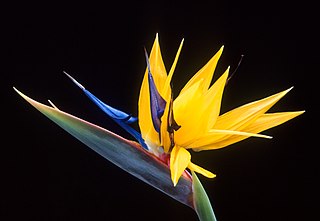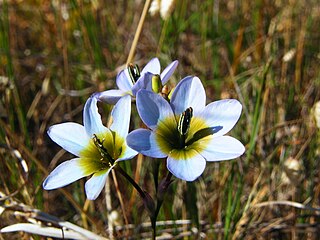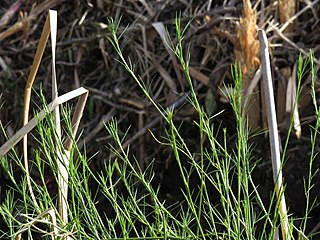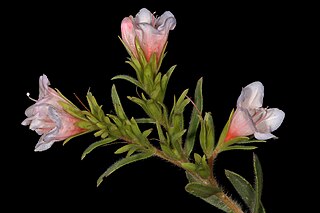
Strelitzia is a genus of five species of perennial plants, native to South Africa. It belongs to the plant family Strelitziaceae. A common name of the genus is bird of paradise flower/plant, because of a resemblance of its flowers to birds-of-paradise. In South Africa, it is commonly known as a crane flower.

Psoralea is a genus in the legume family (Fabaceae) with 111 species of shrubs, trees, and herbs native to southern and eastern Africa, ranging from Kenya to South Africa. In South Africa they are commonly referred to as fountainbush (English); fonteinbos, bloukeur, or penwortel (Afrikaans); and umHlonishwa (Zulu).

Psoralea arborea is a species of legume in the family Fabaceae. It is a shrub or tree endemic to the Cape Provinces of South Africa.

Satyrium coriifolium is a species of orchid endemic to the Cape Provinces. It is commonly known as the orange satyre or Ewwa-trewwa in Afrikaans.

Protea acaulos, also known as the common ground sugarbush, is a flowering plant found in the southwestern Cape Region, South Africa. It is also simply known as ground protea; in the Afrikaans language it is known as an aardroos.

Ixia monadelpha, also known as the pied kalossie or bontkalossie, is an endangered species of geophyte found in wet sandy flats in the southwestern Cape of South Africa.

Leucospermum vestitum is an evergreen, upright to more or less spreading shrub of up to 2½ m (9 ft) high and wide from the family Proteaceae. It has greyish, seated, oblong, 2–3 inch long leaves with two to four teeth near the tip and large, showy two-toned flower heads that are bright orange at first by and age to brilliant crimson. From the center of the perianth emerge long styles, higher up bending towards the center of the head, that jointly give the impression of a pincushion. It is called silky-haired pincushion in English and bergluisie in Afrikaans. It can be found in the Western Cape province of South Africa, and flowers from July until January, peaking October and November.

Protea pendula, also known as the nodding sugarbush or arid sugarbush, is a flowering plant of the genus Protea, in the family Proteaceae, which is only found growing in the wild in the Cape Region of South Africa. In the Afrikaans language it is known as knikkopsuikerbossie or ondersteboknopprotea.

Protea humiflora, the patentleaf sugarbush, is a flower-bearing shrub belonging to the Protea genus. The plant is endemic to South Africa and occurs from the Du Toitskloof Mountains to the Langeberg and Waboomsberg. The plant grows to 2 m in diameter and flowers from July to September with its peak in August.

Colpias is a monotypic genus of flowering plant in the family Scrophulariaceae. It has only one currently accepted species, Colpias mollis, native to South Africa. It secretes oils to attract specialised oil-collecting bees from the genus Rediviva. It is also known by the name klipblom, meaning stone plant in Afrikaans.

Psoralea fascicularis, the large-stipule fountainbush, is a species in the pea or Fabaceae family. It is endemic to the Western Cape province of South Africa where it has been red listed as endangered (EN) by the International Union for Conservation of Nature (IUCN) Red List of Threatened Species due to its declining population.

Lobostemon fruticosus, also known as the eightday healthbush or pyjamabush, is a species of medicinal plant endemic to the Cape Provinces of South Africa. It is considered to be ecologically and economically important but is declining due to overexploitation.
Dianthus bolusii, called the mountain pink or bergangelier, is a species of flowering plant in the family Caryophyllaceae.
Diastella myrtifolia, the Tulbagh silkypuff, is a flower-bearing shrub that belongs to the genus Diastella and forms part of the fynbos. The plant is native to the Western Cape and is found in the Groot Winterhoek. The shrub is erect to semi-erect with mat-shaped spreading branches.

Cyphia volubilis is a species of flowering plant in the genus Cyphia, endemic to the Western Cape. It is a type of Fynbos climbing plant that uses a host to get its own flowers above ground. It has a bilabiate corolla; with 3 lobes on top and 2 at the bottom.

Ixia scillaris is a perennial cormous flowering plant in the genus Ixia. It is endemic to a small portion of the Fynbos in the Western Cape.

Polhillia ignota is a species of flowering plant in the genus Polhillia. Prior to its rediscovery in September 2016, it was known from two specimens, and declared extinct in 2014. There are only 13 plants known, on a small renosterveld fragment less than 3 ha in size. It is endemic to Eendekuil, in the Western Cape.

Aspalathus cordicarpa is a species of flowering plant in the family Fabaceae. Prior to its rediscovery in 2016, Aspalathus cordicarpa was last collected in 1950 and thought to be extinct. It is endemic to the Fynbos region around Garcia's Pass in the Western Cape. It is also known as the Heartfruit Capegorse.
Isoetes stellenbossiensis, the Stellenbosch quillwort or Cape Flats quillwort, is a species of plant from South Africa.
Helichrysum sphaeroideum is a species of flowering plant in family Asteraceae. It is native to the Cape Provinces of South Africa.




















